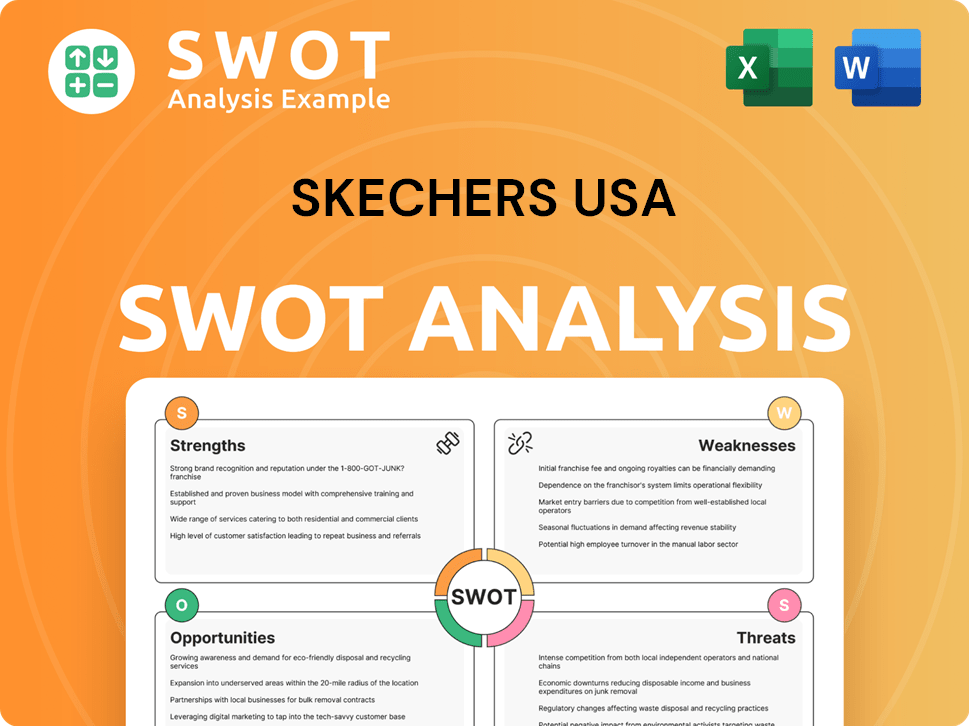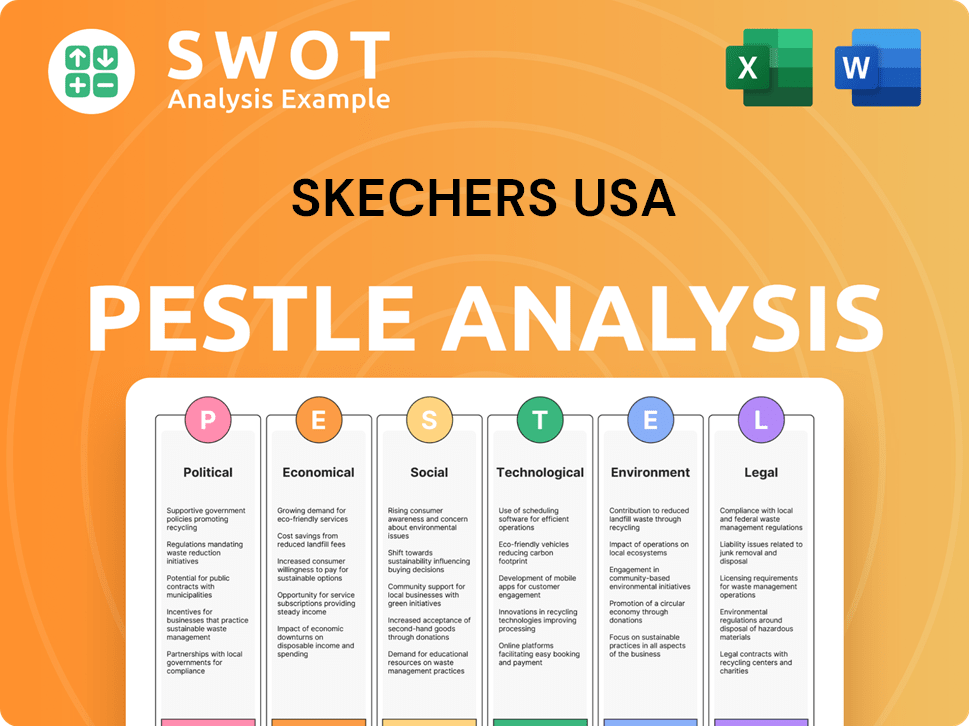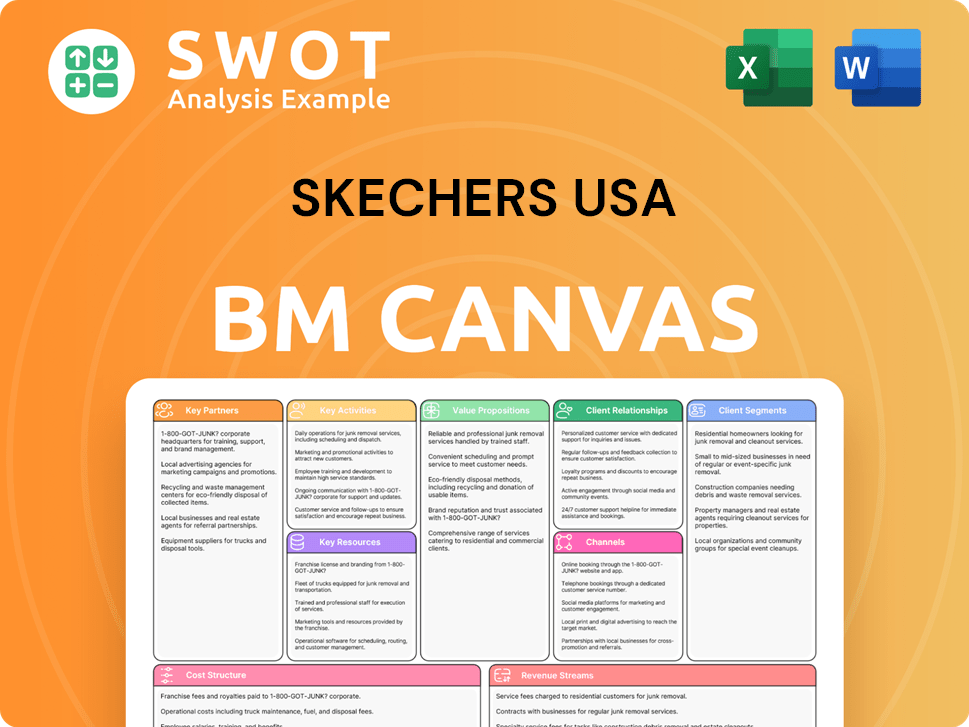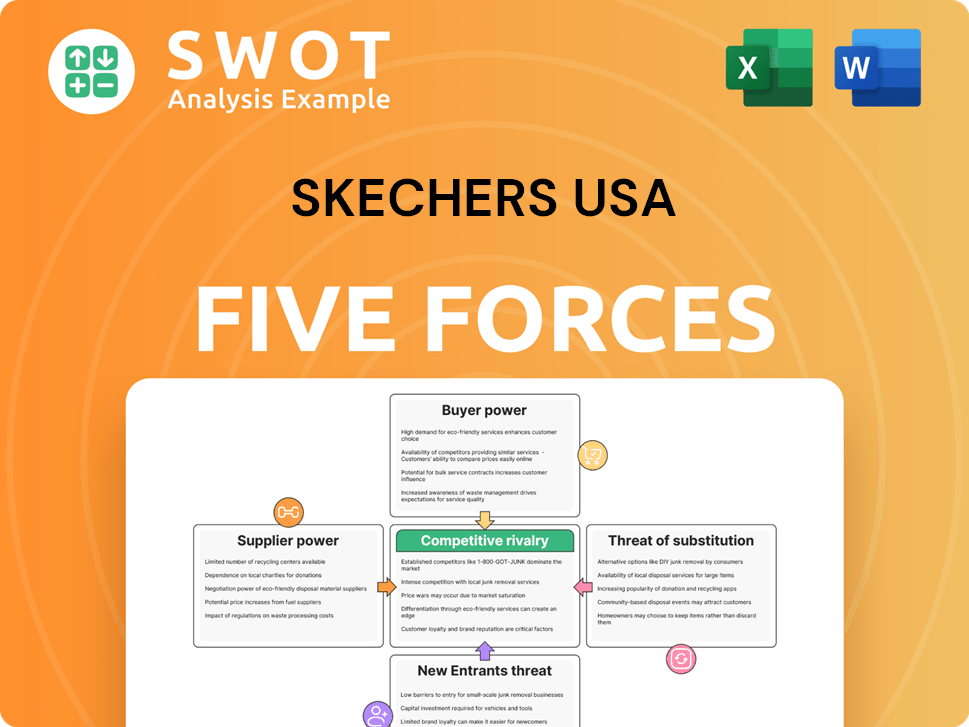Skechers USA Bundle
How Does Skechers USA Thrive in the Global Footwear Market?
Skechers USA, Inc. isn't just a footwear brand; it's a global phenomenon, boasting impressive financial figures and a strong market presence. With record sales of $8.00 billion in 2024, the Skechers USA SWOT Analysis reveals the strategies behind its success. But how does this footwear giant actually operate, and what drives its consistent growth in a competitive landscape?

This exploration of the Skechers business model delves into the company's core operations, from its innovative product development and supply chain to its diverse revenue streams. Understanding Skechers' history and its strategic market positioning is key for investors considering Skechers stock, customers seeking quality, and anyone tracking market trends. We'll examine the factors that contribute to the Skechers company's profitability and its sustained influence, including its marketing strategy and the effectiveness of its distribution channels.
What Are the Key Operations Driving Skechers USA’s Success?
The core operations of the Skechers USA company revolve around the design, development, and marketing of footwear, apparel, and accessories. They cater to a wide customer base, offering products for men, women, and children. The company's value proposition centers on providing innovative designs, comfort technologies, and accessible pricing, making it a popular choice in the footwear market.
The Skechers business model is built on a foundation of in-house design and product development, global sourcing, and extensive distribution networks. Their supply chain is a critical component, with manufacturing partners primarily located in Asia. Skechers manages a complex global distribution network, including wholesale channels and a growing direct-to-consumer presence through retail stores and e-commerce platforms. This multi-channel approach allows them to reach diverse consumer segments effectively.
A key aspect of Skechers' operational strategy is its agile product development cycle. This allows the company to quickly adapt to fashion trends and consumer demands. The company's focus on comfort-driven technologies, such as Memory Foam and Arch Fit, directly benefits customers. As of December 31, 2023, Skechers operated approximately 5,200 stores globally, showcasing its significant retail presence.
Skechers' design process is crucial, focusing on both aesthetics and comfort. They employ in-house teams to create innovative footwear and apparel. This allows them to quickly adapt to market trends and consumer preferences. The design process is a key element of the Skechers products appeal.
Skechers relies on a global network of manufacturing partners, primarily in Asia. This allows them to manage costs and production efficiently. The company focuses on maintaining quality control throughout the manufacturing process. This ensures that each pair meets their standards.
Skechers utilizes a multi-channel distribution strategy, including wholesale and direct-to-consumer sales. Wholesale channels include department stores and specialty retailers. Their direct-to-consumer presence is growing through company-owned stores and e-commerce. This approach helps them reach a wider audience.
The company's marketing efforts are focused on brand awareness and product promotion. They use a mix of advertising, endorsements, and social media. This helps them connect with consumers and build brand loyalty. Skechers' marketing strategy is key to its success.
Skechers' operational success is driven by efficient supply chain management and strategic distribution. The company's ability to adapt to market trends and consumer demands is also a key factor. Understanding the Competitors Landscape of Skechers USA can provide further insights into their market position.
- Agile Product Development: Quick adaptation to fashion trends and consumer demands.
- Comfort Technologies: Emphasis on technologies like Memory Foam and Arch Fit.
- Global Distribution: Extensive network including wholesale and direct-to-consumer channels.
- Retail Presence: Approximately 5,200 stores globally as of December 31, 2023.
Skechers USA SWOT Analysis
- Complete SWOT Breakdown
- Fully Customizable
- Editable in Excel & Word
- Professional Formatting
- Investor-Ready Format

How Does Skechers USA Make Money?
The Skechers USA company generates revenue primarily through the sale of its footwear, apparel, and accessories. The Skechers business model is built on a diversified approach, encompassing wholesale, direct-to-consumer (DTC) retail, and e-commerce platforms. This multi-channel strategy allows the company to reach a broad customer base and maximize its market presence.
In 2024, Skechers reported record annual sales, demonstrating its robust financial performance. The company's revenue streams are strategically managed to ensure sustainable growth and profitability. The direct-to-consumer segment, including retail stores and e-commerce, has shown strong growth.
The Skechers company also utilizes licensing agreements to generate additional revenue. These agreements, though a smaller part of overall revenue, contribute to the brand's global reach and market penetration. The company's tiered pricing strategies cater to different consumer segments, ensuring accessibility and driving sales across various product lines.
Wholesale remains a key revenue stream for Skechers products, accounting for a substantial portion of total sales. This channel involves selling products to retailers and distributors worldwide. In 2023, wholesale sales reached $4.62 billion.
The DTC segment, comprising company-owned retail stores and e-commerce platforms, is a significant growth driver. This channel allows Skechers to control the customer experience and capture higher margins. DTC sales were $3.07 billion in 2023, reflecting a 23.4% increase.
E-commerce is an integral part of Skechers' DTC strategy, enabling the company to reach a global audience. The online store provides convenience and a wide selection of products. Skechers' online presence has expanded significantly, contributing to overall sales growth.
Licensing agreements contribute to Skechers' revenue, though they represent a smaller portion of total sales. These agreements allow the company to expand its brand presence and generate additional income through partnerships. Licensing helps extend the brand's reach.
Skechers employs tiered pricing to cater to different consumer demographics and price sensitivities. This strategy allows the company to offer products at various price points, increasing accessibility. This approach boosts sales across different product lines.
International markets are crucial for Skechers' growth, with significant increases in both wholesale and DTC sales. The Skechers history includes a strategic focus on global expansion. International wholesale sales grew by 13.5% to $2.84 billion, and international DTC sales increased by 28.2% to $1.39 billion in 2023.
The Skechers USA company's focus on expanding its DTC channels is a strategic move to increase profitability and build stronger brand loyalty. The company's financial performance reflects its effective monetization strategies and market positioning. For more details on the company's growth trajectory, you can read about the Growth Strategy of Skechers USA.
Skechers USA PESTLE Analysis
- Covers All 6 PESTLE Categories
- No Research Needed – Save Hours of Work
- Built by Experts, Trusted by Consultants
- Instant Download, Ready to Use
- 100% Editable, Fully Customizable

Which Strategic Decisions Have Shaped Skechers USA’s Business Model?
The journey of the Skechers USA company has been marked by significant milestones and strategic decisions that have shaped its operations and financial outcomes. A key strategy driving revenue growth has been the aggressive expansion into international markets. The introduction of innovative comfort technologies, such as Skechers Arch Fit and Skechers Hands Free Slip-ins, has been pivotal in differentiating the brand and resonating with consumers.
The Skechers business model has adapted to navigate operational challenges, including supply chain disruptions and inflationary pressures, by optimizing inventory management and enhancing operational efficiencies. The company's competitive advantages are rooted in strong brand recognition, built through consistent marketing and celebrity endorsements, and an extensive global distribution network. Skechers continues to evolve by expanding its product categories, including performance apparel and accessories, and investing in its e-commerce capabilities.
The company's ability to rapidly bring new, comfortable, and stylish Skechers products to market at accessible price points further strengthens its competitive edge. The company's strategic moves, including global expansion and product innovation, have positioned it favorably in the competitive footwear market. The company's focus on comfort, style, and value has made it a popular choice for consumers worldwide.
Skechers' history includes significant product launches and strategic expansions. The introduction of innovative technologies, like Arch Fit, has been a major milestone. International expansion has been a primary driver of growth for the Skechers company.
The company's strategic moves involve global expansion and product diversification. Optimizing supply chains and enhancing operational efficiencies are key. Investing in e-commerce and digital marketing is also a priority for the Skechers business model.
Skechers' competitive edge comes from its strong brand recognition and global distribution. The ability to offer comfortable and stylish products at accessible prices is crucial. Continuous innovation and adaptation to consumer preferences are also key.
Skechers USA financial performance reflects its strategic initiatives and market position. International sales represented 63% of total sales in 2023. The company's revenue growth is supported by its global expansion strategy and product innovation.
Skechers has built a strong brand reputation through consistent marketing and endorsements. Its extensive global distribution network allows it to reach a wide customer base. The company's ability to quickly adapt to consumer preferences is also a key advantage.
- Strong brand recognition through marketing.
- Extensive global distribution network.
- Continuous product innovation and adaptation.
- Focus on comfort, style, and value.
To learn more about how the company approaches its marketing, consider reading this article on the Marketing Strategy of Skechers USA.
Skechers USA Business Model Canvas
- Complete 9-Block Business Model Canvas
- Effortlessly Communicate Your Business Strategy
- Investor-Ready BMC Format
- 100% Editable and Customizable
- Clear and Structured Layout

How Is Skechers USA Positioning Itself for Continued Success?
The Skechers USA company holds a prominent position within the global footwear industry, ranking among the top five athletic footwear brands worldwide. The company's success is built on a foundation of comfort, accessible pricing, and a broad appeal that resonates with a diverse customer base. The Skechers business model emphasizes product innovation and a wide-ranging portfolio that caters to various lifestyles and activities, contributing to its sustained market share gains.
However, the Skechers company faces several challenges, including intense competition from industry giants like Nike and Adidas. Additionally, the company is susceptible to supply chain disruptions, fluctuations in foreign currency exchange rates, and the evolving consumer preferences for sustainability and ethical production. Regulatory changes in international markets can also impact operations and profitability, posing further challenges for the company.
Skechers is a top-five global athletic footwear brand, competing with major players. Its focus on comfort, accessible pricing, and broad appeal helps it stand out. The company has seen consistent market share gains, especially in international markets.
The company faces intense competition, potential supply chain disruptions, and currency fluctuations. Evolving consumer preferences and regulatory changes in international markets also pose risks. Sustainability and ethical production are becoming increasingly important.
Skechers aims to continue its growth through international expansion, especially in underserved markets. The company plans to enhance its direct-to-consumer channels through e-commerce and retail expansion. Leadership is confident in reaching $10 billion in annual sales by 2026.
Expansion in underserved markets, direct-to-consumer channel enhancements, and product innovation are key. The company is focusing on new comfort technologies and sustainable materials. These strategies aim to sustain growth and increase market share.
In 2023, international markets accounted for 63% of Skechers' total sales, highlighting its global presence. The company is aiming to reach $10 billion in annual sales by 2026. Skechers continues to innovate its Skechers products with new comfort technologies and sustainable materials to enhance its appeal.
- Skechers' focus on comfort and accessible pricing continues to attract customers.
- The company is expanding its direct-to-consumer channels, including e-commerce and retail stores.
- Continued international expansion is a key strategy for sustained growth.
- The brand is adapting to consumer preferences for sustainable and ethical production.
Skechers USA Porter's Five Forces Analysis
- Covers All 5 Competitive Forces in Detail
- Structured for Consultants, Students, and Founders
- 100% Editable in Microsoft Word & Excel
- Instant Digital Download – Use Immediately
- Compatible with Mac & PC – Fully Unlocked

Related Blogs
- What are Mission Vision & Core Values of Skechers USA Company?
- What is Competitive Landscape of Skechers USA Company?
- What is Growth Strategy and Future Prospects of Skechers USA Company?
- What is Sales and Marketing Strategy of Skechers USA Company?
- What is Brief History of Skechers USA Company?
- Who Owns Skechers USA Company?
- What is Customer Demographics and Target Market of Skechers USA Company?
Disclaimer
All information, articles, and product details provided on this website are for general informational and educational purposes only. We do not claim any ownership over, nor do we intend to infringe upon, any trademarks, copyrights, logos, brand names, or other intellectual property mentioned or depicted on this site. Such intellectual property remains the property of its respective owners, and any references here are made solely for identification or informational purposes, without implying any affiliation, endorsement, or partnership.
We make no representations or warranties, express or implied, regarding the accuracy, completeness, or suitability of any content or products presented. Nothing on this website should be construed as legal, tax, investment, financial, medical, or other professional advice. In addition, no part of this site—including articles or product references—constitutes a solicitation, recommendation, endorsement, advertisement, or offer to buy or sell any securities, franchises, or other financial instruments, particularly in jurisdictions where such activity would be unlawful.
All content is of a general nature and may not address the specific circumstances of any individual or entity. It is not a substitute for professional advice or services. Any actions you take based on the information provided here are strictly at your own risk. You accept full responsibility for any decisions or outcomes arising from your use of this website and agree to release us from any liability in connection with your use of, or reliance upon, the content or products found herein.